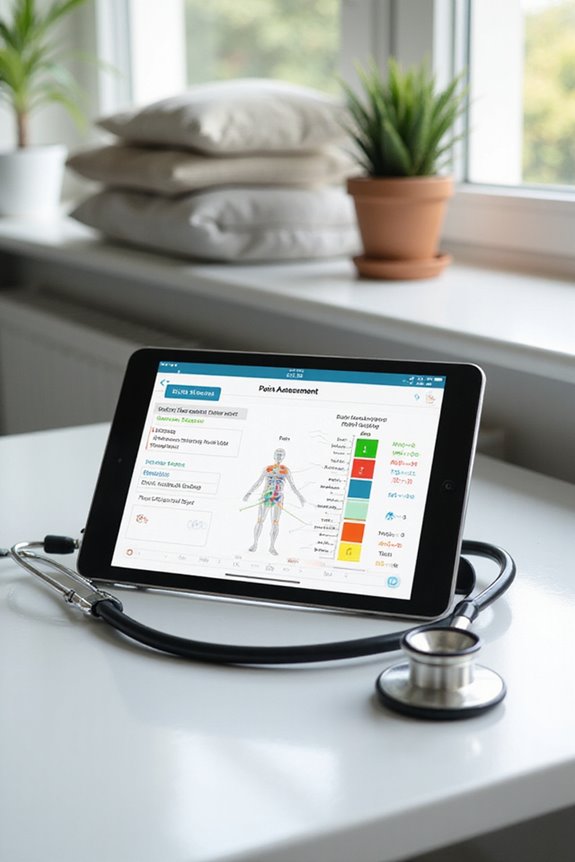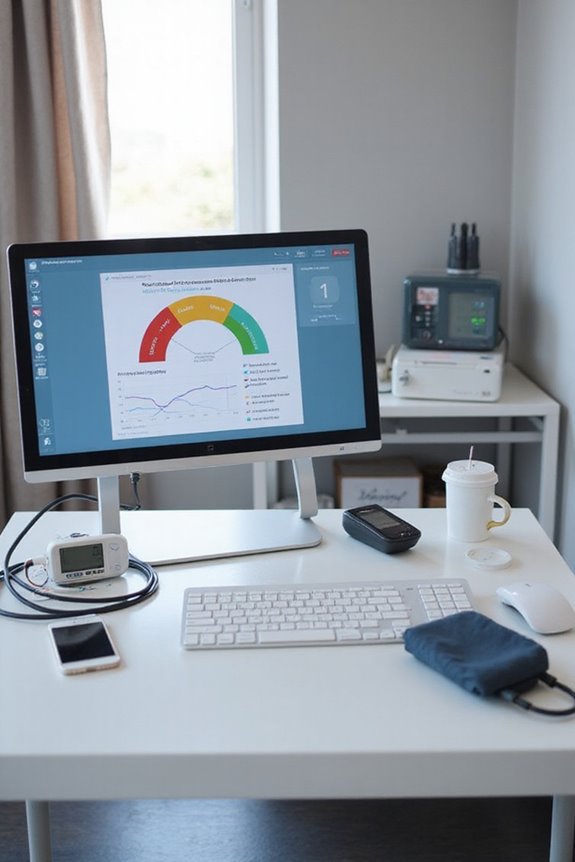Electronic Health Records (EHRs) enhance pain care through several key functions:
- Streamlined workflows improve documentation efficiency.
- Telehealth expands patient access, reducing delays in treatment.
- Centralized records guarantee continuity and accuracy in patient information.
- Automated assessments support personalized pain management strategies.
- Real-time monitoring enables timely interventions.
These components contribute to better clinical decision support and improved patient outcomes, essential for effective pain management. Further insights about the integration of EHRs in pain care are available.
Key Takeaways
- EHRs streamline workflows, enabling faster documentation and reducing clinician workload through standardized templates and automated features.
- Centralized patient records enhance continuity of care, improving information sharing and reducing errors in pain management.
- Telehealth integration allows for timely access to specialists, improving patient engagement and adherence to treatment plans.
- Standardized pain assessments in EHRs ensure consistency and accuracy in documenting patients’ pain profiles for personalized management.
- Real-time analytics and clinical decision support tools facilitate risk stratification and early intervention, enhancing patient outcomes in pain care.
Streamlining Administrative and Clinical Workflows
Streamlining administrative and clinical workflows in pain care through the customization of Electronic Health Records (EHR) is essential for enhancing efficiency and improving patient outcomes. Workflow optimization is achieved by tailoring EHR interfaces to reflect specialized pain management protocols.
- Custom workflows enable faster documentation of assessments, reducing time spent per patient.
- Specialty-specific templates standardize data capture, ensuring consistency in pain scores and treatment plans.
- Integrated alerts support timely clinical decisions, enhancing administrative efficiency.
- Standardized data input improves interoperability across systems, facilitating better communication among multidisciplinary teams.
- Automated features minimize manual entry errors, reducing clinician workload.
These customized EHR solutions ultimately lead to improved productivity and seamless changes in patient care, fostering a cohesive approach to pain management.
Enhancing Patient Access Through Telehealth

Telehealth greatly enhances patient access to specialized pain care, particularly for those residing in rural or underserved areas.
- Telehealth Accessibility: Patients can connect with pain specialists without traveling, effectively reducing geographic barriers.
- Remote Consultations: Virtual visits facilitate timely access to chronic pain management, eliminating long wait times.
- Convenience: Patients avoid transportation issues and exposure risks, allowing for more flexible scheduling that accommodates daily routines.
- Engagement: Telehealth promotes active patient participation through education and regular check-ins, which can improve treatment adherence.
- Support Systems: Family members can easily join remote consultations, enhancing the patient’s support network.
Increased access through telehealth can lead to earlier interventions and better pain outcomes, ultimately improving patient care.
Centralizing Patient Records for Better Continuity of Care

Centralizing patient records through Electronic Health Records (EHRs) greatly enhances continuity of care in pain management.
- EHRs enable real-time access to thorough patient pain histories, facilitating improved information sharing among emergency, primary, and specialty care providers.
- This record synchronization reduces information gaps during care shifts, ensuring cohesive pain management plans.
- Centralized data supports patient engagement, allowing providers to tailor treatment according to longitudinal records that track responses over time.
- Improved accessibility minimizes redundant assessments and mitigates errors related to incomplete medication histories.
- Additionally, embedded individualized pain protocols within EHRs promote adherence to best practices, ultimately enhancing patient outcomes and safety in pain management.
This centralized approach fosters a collaborative healthcare environment, essential for addressing complex pain cases effectively.
Accurate Pain Assessment and Documentation

Accurate pain assessment and documentation are essential components of effective pain management, building upon the centralized patient records that improve continuity of care.
- Standardized pain scales embedded in EHRs help minimize pain scale discrepancies, ensuring consistency in patient-reported pain documentation.
- Thorough and legible records enhance the accuracy of a patient’s pain profile by integrating data from multiple providers.
- Objective assessments enable personalized pain management strategies, while prior treatment details inform future decisions.
- Real-time access reduces documentation errors, supporting timely clinical alerts and decision support tools.
- This structured approach fosters collaboration among care teams, facilitating efficient communication and continuous evaluation of treatment efficacy.
Accurate pain documentation ultimately promotes better clinical outcomes and enhances patient safety.
Predicting and Managing Patient Risk

Predicting and managing patient risk is a critical aspect of effective pain care, greatly influenced by the robust data available within electronic health records (EHRs).
- EHR data analytics allow for risk stratification by identifying key factors such as surgery type, prior pain history, and patient anxiety levels.
- Accurate pain data extraction enhances predictions and enables timely interventions, preventing severe pain syndromes.
- Clinical decision support tools within EHRs display patient risk levels, guiding clinicians in tailoring personalized treatment strategies.
- Real-time monitoring through EHR improves early intervention, reducing adverse outcomes.
- Patient engagement is fostered through EHR platforms that empower individuals to express preferences for non-drug management options, promoting adherence to personalized pain management plans.
This thorough approach optimizes care and promotes safety in pain management.
Supporting Multimodal and Complementary Therapy Choices
Supporting multimodal and complementary therapy choices can markedly enhance patient care in pain management. Electronic Health Records (EHRs) play a pivotal role in this process through:
- Data Integration: EHRs fuse diverse clinical information—clinical notes, imaging, and lab results—to enable personalized multimodal therapy strategies.
- Patient Empowerment: Patients gain real-time access to their health records, fostering informed discussions about treatment options.
- Engagement Platforms: EHR-linked tools support shared decision-making, guiding patients in selecting complementary therapies like acupuncture or cognitive behavioral therapy.
- Tracking and Compliance: EHRs allow patients to monitor treatment adherence and efficacy, tailoring regimens based on personal data.
- Equitable Access: Accessible EHRs reduce disparities, ensuring all patients can explore multimodal options for pain management.
This integrative approach ultimately enhances patient outcomes in pain care.
Comprehensive Management of Patient Records
Thorough management of patient records plays a crucial role in enhancing pain care. Electronic Health Records (EHRs) guarantee:
- Enhanced Documentation: Accurate recording of pain levels enables tracking and detailed longitudinal evaluations.
- Centralized Access: Extensive pain histories are readily accessible to multiple clinicians, promoting continuity of care.
- Adherence Monitoring: EHRs facilitate real-time tracking of pain management protocols, improving outcomes and compliance.
- Quality Measurement: EHR data serve as critical resources for evaluating healthcare quality indicators and conducting research.
Moreover, patient engagement is fostered through streamlined communication and shared access to pain management plans. Data security remains a priority, guaranteeing that sensitive patient information is protected while supporting effective pain care strategies. Consequently, extensive management of patient records is essential for optimized pain treatment.
Improving Clinical Decision Support
Improving clinical decision support (CDS) systems is essential for enhancing pain management practices within healthcare settings.
- Evidence Integration: CDS tools embed evidence-based guidelines, promoting standardized care and adherence to national protocols.
- Patient Engagement: Summarizing key pain metrics and treatment histories facilitates meaningful discussions between clinicians and patients.
- Real-Time Alerts: Automated alerts for opioid interactions and patient risks enhance safety and streamline workflows.
- Personalized Contextualization: CDS incorporates patient-specific factors, allowing tailored treatment plans instead of generic approaches.
- Shared Decision-Making: By summarizing complex data in accessible formats, CDS encourages transparency and active patient involvement in care.
These advancements not only improve clinical outcomes but also foster a collaborative environment, ultimately enhancing the overall patient experience.
Monitoring and Adjusting Pain Management Plans
Monitoring pain management plans is a systematic process that leverages electronic health records (EHRs) to enhance patient care. EHRs facilitate dynamic pain adjustments through standardized documentation of pain assessments, incorporating both clinician-observed and patient-reported metrics.
Key features include:
- Real-time monitoring of pain levels, allowing for timely interventions.
- Automated alerts for reassessment, ensuring that worsening symptoms receive immediate attention.
- Customizable templates designed for extensive pain management tracking.
EHRs also support individualized adjustments by integrating patient-specific data, which helps in identifying high-risk individuals and enhancing treatment efficacy. This structured approach ultimately promotes effective communication among healthcare providers, fostering a collaborative environment focused on optimizing pain management strategies.
Driving Evidence-Based Outcomes in Pain Care
Driving evidence-based outcomes in pain care is increasingly reliant on the effective utilization of electronic health records (EHRs).
- EHR data facilitates evidence generation by establishing standardized definitions for pain-related care processes, such as prolonged opioid use.
- This data supports outcome evaluation through real-world insights into pain management practices and patient outcomes.
- Frameworks derived from EHR data enable the external validation of pain management models across various healthcare systems, enhancing quality measurement.
- Individualized Pain Plans (E-IPPs), implemented in emergency departments, have shown potential for improving patient experiences and provider confidence.
- EHR nudges have been associated with improved patient-reported pain intensity, although evidence on their impact on medication adherence is mixed.
Frequently Asked Questions
How Do EHRS Impact Patient Privacy and Data Security in Pain Management?
Electronic health records greatly impact patient privacy and data security in pain management through data encryption and requiring patient consent. These measures guarantee sensitive information remains confidential, fostering trust and a sense of belonging among patients.
What Are the Costs Associated With Implementing EHR Systems in Pain Clinics?
Implementation expenses for EHR systems in pain clinics encompass software licensing, hardware investments, and training costs. These financial commitments can greatly impact clinic budgets, necessitating careful planning to optimize resources and guarantee effective patient care integration.
How Do EHRS Facilitate Communication Between Different Healthcare Providers?
EHRs foster interdisciplinary collaboration, juxtaposing fragmented communication with streamlined referrals. This centralization enables providers to share essential patient information efficiently, cultivating a cohesive care environment where each member feels valued and connected in patient management.
Can EHRS Improve Patient Engagement in Their Own Pain Management?
EHRs enhance patient engagement in pain management through effective treatment tracking and accessible patient education. By allowing patients to monitor symptoms and participate actively, they foster a sense of community and shared responsibility in healthcare decisions.
What Challenges Do Clinics Face When Transitioning to EHR Systems for Pain Care?
Moving to EHR systems presents persistent pitfalls, including problematic workflow integration challenges and pressing staff training issues. These obstacles often hinder clinics’ efforts, complicating care continuity and creating discomfort among healthcare professionals steering through new digital landscapes.





